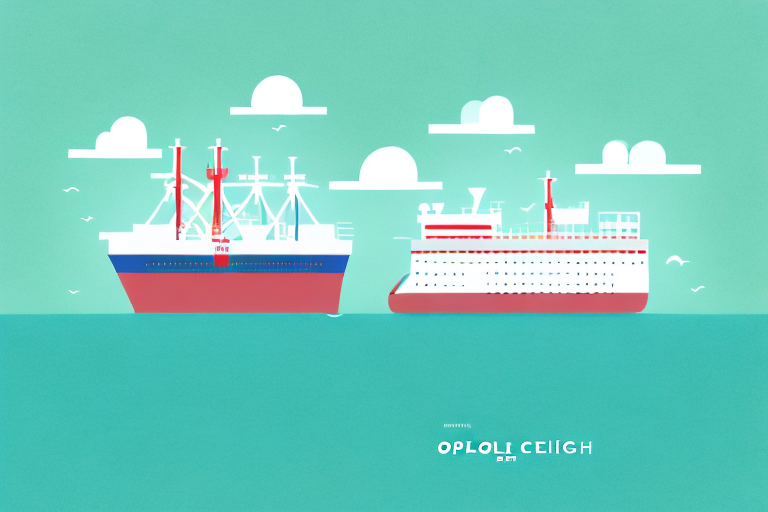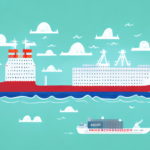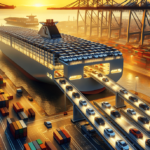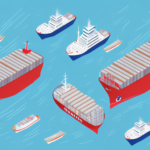Commercial shipping has played a critical role in global trade for thousands of years. From the earliest days of seafaring vessels to the modern era of cargo ships and containerization, the shipping industry has enabled the movement of goods and materials across the world. In this article, we will explore the many benefits of commercial shipping including its economic impact, support of supply chain management, environmental sustainability, and career opportunities.
The History of Commercial Shipping: From Ancient Times to Modern Day
The origins of commercial shipping can be traced back to ancient civilizations such as the Egyptians and Phoenicians, who used boats to transport goods along rivers and sea coasts. In the Middle Ages, trade routes expanded with the development of the Mediterranean and Baltic Sea trade networks. The rise of European powers like Spain, Portugal, and the Netherlands further expanded trading activities with the development of transatlantic shipping routes.
In the 19th century, the advent of steam power revolutionized the shipping industry, making voyages faster and more reliable. The introduction of containerization in the 1950s and 60s transformed the industry by standardizing the size and shape of cargo containers, simplifying the handling and transportation of goods. Today, commercial shipping is a vital part of the global economy, connecting businesses and consumers worldwide.
However, the shipping industry has also faced challenges throughout history. Piracy has been a constant threat, with modern hotspots including the Gulf of Aden and the Strait of Malacca. Additionally, the industry must continuously adapt to evolving environmental regulations aimed at reducing its carbon footprint.
The Economic Impact of Commercial Shipping on Global Trade
Commercial shipping serves as the backbone of global trade, enabling the movement of products and raw materials across borders and oceans. According to the United Nations Conference on Trade and Development (UNCTAD), over 80% of global trade by volume and more than 70% by value is carried by sea. In 2022, the global maritime transport industry was responsible for transporting approximately 11.5 billion tons of cargo.
The industry significantly contributes to the world economy by facilitating international trade, creating jobs in shipbuilding, logistics, and port operations, and generating revenue through shipping services. For instance, the International Chamber of Shipping estimates that the global shipping industry directly employs around 1.5 million seafarers and supports millions of jobs in related sectors.
Additionally, commercial shipping is capital-intensive, requiring substantial investment in vessels, infrastructure, and technology. This investment drives economic growth and technological advancements within the industry.
How Commercial Shipping Supports Supply Chain Management
Commercial shipping is integral to supply chain management, ensuring the efficient movement of goods from manufacturers to consumers. The ability to transport large volumes of goods economically over long distances makes shipping indispensable for globalized businesses.
Modern shipping logistics leverage technologies such as Automatic Identification Systems (AIS) and Blockchain to enhance transparency and traceability. For example, blockchain technology enables secure and immutable records of cargo movements, reducing the risk of fraud and errors. This level of transparency helps supply chain managers optimize routes, manage inventory, and respond swiftly to disruptions.
Furthermore, commercial shipping supports just-in-time (JIT) inventory systems, allowing businesses to minimize inventory costs and increase efficiency. By coordinating shipping schedules with production and distribution timelines, companies can ensure timely delivery of products to the market.
The Environmental Impact of Commercial Shipping and Sustainable Solutions
While commercial shipping is essential for global trade, it has significant environmental impacts. The industry accounts for approximately 2-3% of global greenhouse gas emissions, primarily from the burning of heavy fuel oil used by ships. Additionally, shipping activities contribute to marine pollution through oil spills, ballast water discharge, and the release of pollutants like sulfur oxides (SOx) and nitrogen oxides (NOx).
To mitigate these impacts, the International Maritime Organization (IMO) has implemented regulations such as the IMO 2020 sulfur cap, which limits sulfur content in marine fuels. Shipping companies are also adopting alternative fuels like liquefied natural gas (LNG), hydrogen, and ammonia to reduce carbon emissions.
Innovations such as wind-assisted propulsion, energy-efficient hull designs, and the use of scrubbers to remove pollutants from exhaust gases are being implemented to enhance sustainability. Additionally, the adoption of digital technologies for route optimization helps reduce fuel consumption and emissions.
Efforts are also being made to develop autonomous ships that can operate more efficiently and safely, further reducing the environmental footprint of commercial shipping.
Navigating the Challenges and Risks of Commercial Shipping
Commercial shipping faces numerous challenges and risks that can disrupt operations and impact global trade. Key challenges include:
- Piracy and Security: Piracy remains a significant threat in regions like the Gulf of Aden and the South China Sea, posing risks to crew safety and cargo security.
- Geopolitical Instability: Political tensions and conflicts can lead to the closure of critical shipping routes, affecting global supply chains.
- Environmental Regulations: Compliance with stringent environmental regulations requires substantial investment in cleaner technologies and fuels.
- Economic Fluctuations: Global economic downturns, such as those caused by the COVID-19 pandemic, can lead to reduced demand for shipping services.
Effective risk management strategies are essential for mitigating these challenges. These include investing in robust security measures, diversifying shipping routes, adhering to regulatory requirements, and adopting flexible operational practices to respond to economic changes.
Commercial Shipping Regulations and Compliance Requirements
The commercial shipping industry is governed by a complex framework of international, national, and local regulations aimed at ensuring safety, security, and environmental protection. Key regulatory bodies include the International Maritime Organization (IMO), the International Labour Organization (ILO), and various national maritime authorities.
Important regulations and conventions include:
- International Convention for the Safety of Life at Sea (SOLAS): Establishes safety standards for the construction, equipment, and operation of ships.
- International Convention for the Prevention of Pollution from Ships (MARPOL): Sets regulations to prevent marine pollution from ship operations.
- International Ship and Port Facility Security (ISPS) Code: Provides measures to enhance the security of ships and port facilities.
Compliance involves regular inspections, obtaining necessary certifications, and implementing standardized procedures. Non-compliance can result in severe penalties, including fines, vessel detainment, and loss of operating licenses.
The Role of Technology and Innovation in Modern Commercial Shipping
Technology and innovation are driving significant advancements in the commercial shipping industry, enhancing efficiency, safety, and sustainability. Key technological trends include:
- Automation and Autonomy: The development of autonomous ships and automated port operations is streamlining processes and reducing labor costs.
- Blockchain Technology: Enhances transparency and traceability in supply chains by providing secure and immutable records of transactions and cargo movements.
- Internet of Things (IoT): Sensors and connected devices enable real-time monitoring of ship performance, cargo conditions, and environmental parameters.
- Big Data and Analytics: Advanced data analytics facilitate predictive maintenance, route optimization, and informed decision-making.
These innovations not only improve operational efficiency but also contribute to reducing the environmental impact of shipping by optimizing fuel usage and minimizing emissions.
Exploring Different Types of Commercial Ships and Their Functions
The commercial shipping industry encompasses a diverse range of vessel types, each designed for specific functions. Common types include:
- Container Ships: Transport standardized cargo containers, facilitating easy loading and unloading, and enhancing efficiency in global trade.
- Tanker Ships: Designed to carry liquid cargoes such as crude oil, refined petroleum products, and liquefied natural gas (LNG).
- Bulk Carriers: Transport unpackaged bulk cargo like coal, grain, and minerals in large quantities.
- Roll-On/Roll-Off (RoRo) Ships: Specialized for transporting vehicles and machinery that can be driven on and off the vessel.
- Refrigerated Ships (Reefers): Equipped with temperature-controlled storage for transporting perishable goods like food and pharmaceuticals.
Each vessel type is engineered to optimize the transportation of specific cargoes, ensuring safety, efficiency, and cost-effectiveness in shipping operations.
Careers in the Commercial Shipping Industry: Opportunities and Requirements
The commercial shipping industry offers a wide range of career opportunities, catering to diverse skill sets and interests. Key career paths include:
- Maritime Operations: Roles such as ship captain, deck officer, and marine engineer, responsible for the navigation and maintenance of vessels.
- Logistics and Supply Chain Management: Positions focused on coordinating the movement of goods, managing supply chains, and optimizing shipping routes.
- Port Management: Careers in managing port facilities, overseeing cargo handling, and ensuring efficient port operations.
- Maritime Law and Compliance: Specializing in the legal aspects of shipping, including contracts, regulations, and dispute resolution.
- Environmental Management: Focusing on sustainability initiatives, pollution control, and compliance with environmental regulations.
Education and training requirements vary by role. Many positions require specialized degrees in maritime studies, engineering, logistics, or business administration. Certifications from bodies like the International Maritime Organization (IMO) are often necessary for operational roles.
Conclusion
Commercial shipping is an indispensable component of global trade, facilitating the movement of goods and supporting economic growth worldwide. The industry continues to evolve through technological advancements and sustainable practices, addressing environmental challenges while enhancing efficiency and reliability. Despite facing risks such as piracy, geopolitical instability, and regulatory pressures, the commercial shipping sector remains resilient and adaptable. As the industry embraces innovation and sustainability, it will continue to play a pivotal role in connecting businesses and consumers around the globe, offering diverse career opportunities and driving future economic development.




















